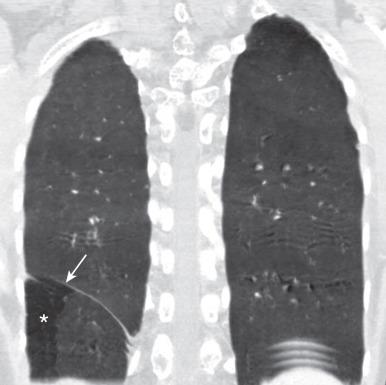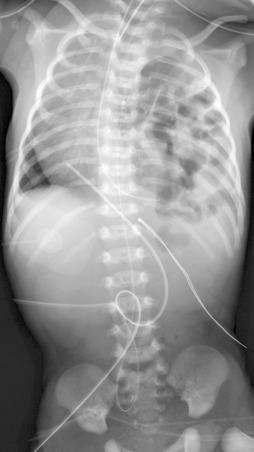Physical Address
304 North Cardinal St.
Dorchester Center, MA 02124
The diaphragm is a dome-shaped musculofibrous membrane that separates the thoracic and abdominal cavities and performs an important respiratory function. The diaphragm has a fibrous portion centrally (i.e., a central tendon) surrounded by a peripheral muscular portion. Major structures pass through three openings: caval (inferior vena cava and some right phrenic nerve branches), esophageal (esophagus, vagal nerves, and small esophageal arteries), and aortic (aorta, azygous vein, and thoracic duct). The diaphragm is innervated by the phrenic nerve, which is formed from the central nerves of C3, C4, and C5. Diaphragmatic lesions can arise from a variety of congenital, traumatic, infectious, and neoplastic conditions.
Duplication of the diaphragm, also known as an accessory diaphragm, is a rare congenital anomaly. It is almost always located on the right side and frequently is associated with lobar agenesis-aplasia complex. Although the precise pathogenesis of duplication of the diaphragm is currently unknown, it is suggested that this anomaly is the result of a defect of synchronization between the caudal migration of the septum transversum and the development of the bronchial system. In gross pathology, the accessory diaphragm is a fine fibromuscular membrane with a serosal lining that is connected to the anterior part of the diaphragm. It follows a posterosuperior direction to join the posterior chest wall, separating the right hemithorax into two parts. It is crescentic in form and usually has an opening (i.e., central hiatus) medially, through which vessels and bronchial structures pass. Affected patients may be asymptomatic, but most present with respiratory difficulties of varying degrees.
On chest radiographs or computed tomography (CT), the accessory diaphragm may have two different appearances. When the central hiatus is markedly narrowed and the trapped lung is not aerated, it appears like a mass. However, when the trapped lung is aerated, the accessory diaphragm is seen as a fissure-like structure in the right base extending from the anterior aspect of the hemidiaphragm cephalad toward the posterior chest wall. On CT, it is seen as a bandlike structure with crowding of pulmonary structures as the bronchi and vessels traverse the central hiatus ( Fig. 61.1 ).

Most duplicated diaphragms require no surgical intervention or other treatment. Surgical repair should be performed only when dyspnea or recurrent respiratory infections occur.
Traditionally, congenital diaphragmatic hernias (CDHs) have been classified according to their anatomic location. Almost 90% of CDHs are reported to involve the posterolateral aspect of the diaphragm and are referred as to Bochdalek hernias. Nonposterolateral CDHs occur most often in the anterior portion of the diaphragm and are known as Morgagni hernias. However, diaphragmatic defects do not exclusively localize to these two areas, and thus some defects do not follow this classification. In addition, some diaphragmatic hernias have a sac, which is thought to represent focal thinning of the diaphragmatic musculature. Thus the terms sac hernia and eventration currently are poorly defined. Despite its limitations, an anatomic-based classification system continues to be used ( Box 61.1 ).
Posterolateral (Bochdalek)
Parasternal (Morgagni)
Central
Posteromedial
Anterolateral
The prevalence of CDH has been reported as ranging from 1.6 to 2.3 per 10,000 births, including isolated cases and those associated with other malformations. CDH of the Bochdalek type is associated with significant morbidity and mortality, and accounts for 90% to 95% of CDH. Approximately 85% of these hernias occur on the left side, whereas right-sided and bilateral hernias represent only 13% and 2% of cases, respectively.
The diaphragm initially develops as a septum between the heart and the liver, progresses posterolaterally, and closes at the Bochdalek foramen at approximately 8 to 10 weeks of gestation. The primary abnormality resulting in a Bochdalek hernia is failure or delay of the pleuroperitoneal fold and transverse septum to properly fuse with the intercostal muscles around the eighth week of gestation. Diaphragmatic hernia and lung hypoplasia can occur concomitantly, possibly a polygenic association.
Many cases of CDH are initially found prenatally by ultrasound (US) or magnetic resonance imaging (MRI) (see Chapter 50 ). On a newborn chest radiograph a Bochdalek hernia may appear as an opacified hemithorax with contralateral cardiomediastinal shift. As the infant swallows air, the air-filled bowel located within the hemithorax may become apparent ( Fig. 61.2 ). In the case of intraabdominal solid organ herniation, the hemithorax can remain homogeneously opacified. When the bowel-containing hernia is large, a paucity of abdominal contents causes the so-called “scaphoid abdomen” and can be seen on abdominal radiographs. The position of catheters and tubes is helpful in confirming the presence of a Bochdalek hernia. The nasogastric (NG) tube deviates to the side opposite to the hernia in the chest. If the stomach is herniated within the hemithorax, the tip of the NG tube can project in the chest. The position of umbilical venous catheters is affected by the location of the liver, which is shifted either in the abdomen or chest. In contrast, the position of umbilical arterial catheters is rarely affected because of their retroperitoneal location. Ultrasound with color Doppler may help delineate the venae cavae and the hepatic vasculature, and it may identify the presence of herniated solid organs before surgery. CT and MRI may play an occasional role in excluding a congenital lung anomaly such as congenital pulmonary airway malformation or pulmonary sequestration.

After hernia repair, an ipsilateral pneumothorax is a common finding and should not be rapidly evacuated as this may cause mediastinal rotation and subsequent venae cavae obstruction because of the increased mobility of the neonatal mediastinum. The pleural air typically reabsorbs by itself and sometimes is replaced by fluid.
Treatment of all types of CDH includes medical and surgical management. The medical management of CDH focuses on addressing the underlying major causes of neonatal death as a result of CDH, such as pulmonary hypoplasia and pulmonary hypertension. It includes the use of extracorporeal membrane oxygenation, high-frequency ventilation, and inhaled nitric oxide. Surgical repair of CDH is performed with a transabdominal or transthoracic approach, and more recently, laparoscopic or thoracoscopic techniques have evolved. The herniated abdominal viscera are removed from the chest and repositioned in the abdomen. The posterolateral diaphragmatic defect is usually closed with nonabsorbable sutures if the defect is small or with a prosthetic patch if the defect is larger than 5 cm. Currently no specific guideline exists for following up on children with a repaired CDH. However, chest radiographs often are obtained routinely for confirmation of an intact diaphragm and early detection of a possible CDH recurrence. On follow-up chest radiographs, abnormalities including persistent lung hypoplasia, decreased pulmonary vascularity, and mediastinal shift may be observed.
Become a Clinical Tree membership for Full access and enjoy Unlimited articles
If you are a member. Log in here